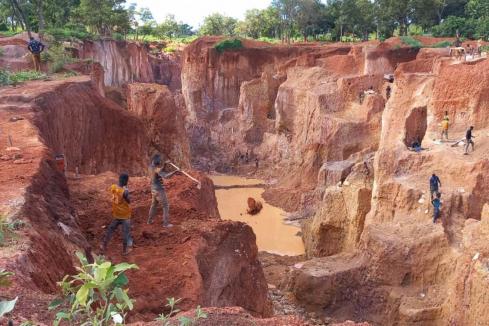Aurum Resources has been buoyed by encouraging gold recoveries of up to 99.4 per cent from independent testwork on diamond drill core from two key targets within its BD tenement at Boundiali in Côte d'Ivoire, West Africa. The scoping metallurgical tests demonstrate excellent potential for high gold recoveries at a relatively coarse grind size of 80 per cent passing a screen size of 106 microns or 0.106 millimetres.


Aurum Resources has been buoyed by encouraging gold recoveries of up to 99.4 per cent from independent testwork on diamond drill core from two key targets within its BD tenement at Boundiali in Côte d'Ivoire, West Africa.
The scoping metallurgical tests demonstrate excellent potential for high gold recoveries at a relatively coarse grind size of 80 per cent passing a screen size of 106 microns (P80106µm) or 0.106mm.
Aurum has engaged Perth-based engineering and construction company MACA Interquip Mintrex to manage the scoping study metallurgical testwork for its 1037 square kilometre Boundiali gold project, overseen by ALS in Perth.
Following comminution (grind amenability) tests, seven sets of composite samples from the BD1 and BD2 targets were selected for gold cyanidation and gravity recovery tests, with each set comprising three samples.
For cyanidation, each sample was subjected to a primary grind size of either 150µm, 106µm or 75µm (0.15mm, 0.106mm or 0.075mm).
Each sample was subjected to cyanidation leaching under set standard conditions over a continuous period of eight, 24 and 48 hours, with gold analysed and recoveries calculated at the end of each interval, including selected gravity separation testwork.
The first step in the test regimen was to determine the extractable gold with a whole-of-ore leach on each composite at the three primary grind sizes.
Selected composites were then subjected to gravity concentration before leaching to determine the merits of including gravity separation in the gold recovery process.
After an initial eight-hour leach the best recovery achieved was 98.2 per cent from a sample ground to a fine P8075µm. The same sample also achieved 99.4 per cent recovery after 24 hours and 48 hours, also from the 75µm grind size.
Throughout the tests, more than 80 per cent of the available gold was extracted after eight hours, demonstrating rapid gold leaching kinetics in each sample, regardless of the grind size.
Only two of the 21 samples, both containing the coarsest primary grind size group of P80 150µm, did not attain 90 per cent gold extraction over the full 48 hours leach duration.
Aurum says in most of the composites, gold recovery was lower at the coarsest primary grind size of P80 of 150µm, while gold recoveries were better and similar across each composite at primary grind sizes of P80 of 75µm and 106µm.
Additional relevant work involved subjecting composite samples to gravity concentration testwork employing a laboratory-scale Knelson concentrator.
The study aimed to determine the amount of gravity separable gold that could be expected from the three grind sizes.
The information from that work also feeds back to future resource modelling and operational grade control principles and practices.
The tests demonstrated that the composites contain a remarkably high proportion of gravity gold, with between 29.3 and 56 per cent of the total gold in the samples being recoverable by gravity.
Leaching of the gravity tails reveals notably lower lime and cyanide consumptions, with a decrease of 25 per cent in lime consumption and a 40 per cent decrease in cyanide consumption at a P80 of 106µm, when compared to cyanide leaching undertaken on whole-of-ore samples.
Aurum Resources’ managing director Dr Caigen Wang said: “This scoping study level testwork has reported very promising results, demonstrating the potential for a standard free-milling gravity and CIL circuit following a single-stage crushing and SAG milling (SSAG). The BD gold mineralisation looks to have a moderate to high proportion of gravity-recoverable gold for all domains and ore characteristics favouring a coarse primary grind size P80 of 106µm with leaching of about 24 hours for total gold recovery including gravity and leaching of between 95-99%.”
Dr Wang says the company still has more leach and gravity testwork underway and will require additional variability samples to firm up the encouraging initial results.
Other testwork undertaken contributes to the overall conclusion that the BD gold mineralisation style, as represented by the initial samples from the company’s BD1 and BD2 targets, can be classified as medium to moderately hard, easily crushed, free-milling and well-suited to a single-stage SAG (semi-autogenous) milling circuit.
The favourable metallurgical characteristics established so far point to requiring no more than a standard carbon-in-leach circuit at Boundiali for the likely BD ore, with a Knelson-style or similar gravity gold recovery circuit.
In other news, Aurum says its takeover of Mako Gold, announced on October 11, is now unconditional and the merger will bring greater scale and market presence to the company with a stronger platform for future growth and success.
Aurum’s six rigs remain fully-occupied on its high priority targets at Boundiali and the company remains well-funded for its proposed drilling campaigns, with more than $19 million on hand as of the end of September, as it aims to deliver its first JORC resource before Christmas this year.
Is your ASX-listed company doing something interesting? Contact:













